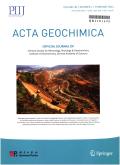Petrogenesis and geodynamic setting of the Wutang granites in the Tong’an-Baishuidong lithium mining district, South China: Evidence from monazite U–Pb chronology, geochemistry, and Nd–Pb isotope
Abstract
The Tong’an-Baishuidong mining district (TBMD), located in the eastern section of the Jiangnan Orogen, is a newly discovered granite-type lithium mining district. Thisstudy presents new monazite U–Pb chronological, whole-rock geochemical, and Nd–Pb isotopic data to reveal the petrogenesis and geodynamic setting of the Wutang granites in the TBMD. The monazite U–Pb age of 145.8 ± 1.0 Ma indicates that the granites were emplaced at the end of the Late Jurassic. Whole-rock geochemical results demonstrate that the Wutang granites are enriched in SiO2 (72.80–73.40 wt%) but depleted in CaO (0.44–0.90 wt%) and MgO+TiO2+TFeO (1.79–2.05 wt%). These granites exhibit negative Eu anomalies (δEu = 0.3−0.4) and high aluminum saturation indexes (A/CNK = 1.2−1.6), differentiation indexes (DI = 90–92), and Rb/Sr ratios (4.7–8.1). They also have moderate Ba contents (239–278 ppm) and low Sr contents (52.7–82.0 ppm) as well as low Nb/Ta (2.2–5.3) and Zr/Hf (21.3–31.5) ratios. All these indicate that they are highly fractionated granites. Additionally, these granites contain 5–10 wt% muscovite but no hornblende, with calculated corundum contents of 2.3–5.5 wt%. They have low high-field strength element (HFSE) contents (Zr + Nb + Ce + Y = 182–202 ppm) and zircon saturation temperatures (700–770 °C), with Th and Y negatively linked with Rb. These petrographic and geochemical features further reveal that the Wutang granites belong to highly fractionated S-type granites. The εNd(t) values of these granites range from −9.03 to −8.23, corresponding to two-stage model ages (TDM2) of 1488–1553 Ma. The initial Pb isotope ratios are: (206Pb/204Pb)i = 18.38–18.55, (207Pb/204Pb)i = 15.67–15.68, and (208Pb/204Pb)i = 38.62–38.67. These Nd–Pb isotopic results demonstrate that the parental magma originated from the partial melting of ancient crustal materials. In the meantime, the TBMD in the eastern section of the Jiangnan Orogen was in a compression-extension transitional setting associated with the episodic subduction of the Paleo-Pacific Plate.

 求助内容:
求助内容: 应助结果提醒方式:
应助结果提醒方式:


